
The Florida Keys from Google Earth Maps
Key West, Florida - 2011
Updated: 06/16/11
The Florida Keys is a 125 mile chain of 1,700 islands linked by more than 40 bridges. Driving south on Overseas Highway 1, the Atlantic Ocean is on your left and the Gulf of Mexico is your right.

The Florida Keys from Google Earth Maps
We left Big Cypress for a side trip to Key West. Not wanting to make the entire trip in one day, we made a reservation in Marathon for two nights. That got us close enough to Key West to make the remainder of the trip and enjoy most of the day in Key West.
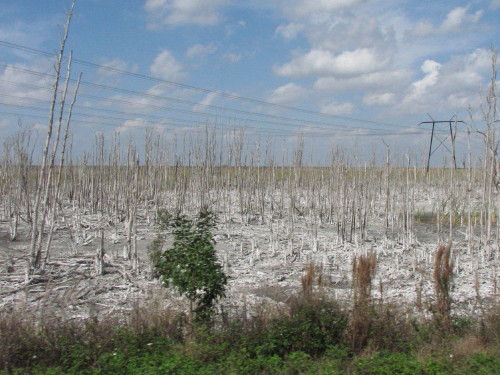 Along the way we saw what appeared to be a dried up salt pond.
Winter is the dry season. If we were
here in the summer there would probably be standing water.
Along the way we saw what appeared to be a dried up salt pond.
Winter is the dry season. If we were
here in the summer there would probably be standing water.
We also saw utility poles braced due to ground conditions like the ones we saw braced in Alaska braced due to the Tundra.
Near Homestead, Florida we drove by an area with many nurseries growing crops from vegetables to palm trees. They were very large operations.
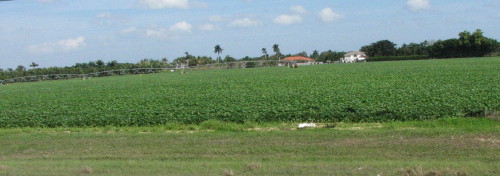
The people in Florida use a lot of pastel colors.
Even the cement road dividers
were painted a pastel blue.
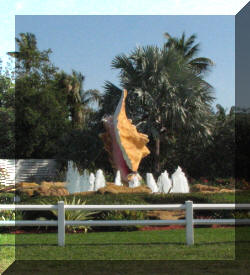 This
is a huge conch shell. (More about the Conch Republic later.)
This
is a huge conch shell. (More about the Conch Republic later.)
The water and the islands along the route were beautiful.

Utility poles were in the water and parallel to the many bridges. We wondered
out loud, why the cables were not laid underwater.
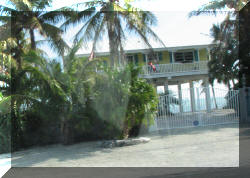 Many
houses
built at or near sea level we built on stilts.
Many
houses
built at or near sea level we built on stilts.
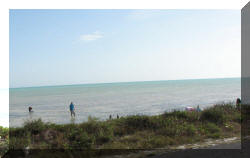 There
were a few areas along the road developed as beaches for recreation.
There
were a few areas along the road developed as beaches for recreation.
Some people improvised wherever they could find access.
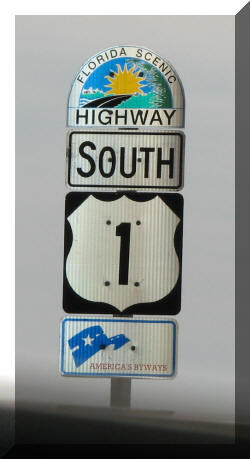 The
route through the Keys . . .
The
route through the Keys . . .
We picked it up in Florida City.
Approaching Marathon we could see what looks like a farm in the distance in the Gulf of Mexico. In Maine, the farms were growing Mussels. If this is a farm, we have no idea what is growing.
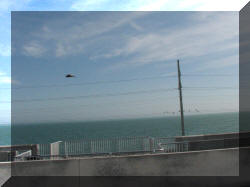 The
bridges we drove on were the 'newer' bridges. In most areas, the prior bridges
were still standing. The prior bridges were originally railroad bridges. A hurricane threw
what was then Henry Flagler's Railroad into bankruptcy. Many sections of the
railroad had been severely damaged. It was agreed that something had to be done to reconnect Key West
to the mainland. The state purchased the right-of-way for $640,000 to be
modified into a highway for automobiles. The Overseas Highway was born. It took
almost three years but it was completed and opened for car traffic to travel from
the mainland to Key West in 1938.
The
bridges we drove on were the 'newer' bridges. In most areas, the prior bridges
were still standing. The prior bridges were originally railroad bridges. A hurricane threw
what was then Henry Flagler's Railroad into bankruptcy. Many sections of the
railroad had been severely damaged. It was agreed that something had to be done to reconnect Key West
to the mainland. The state purchased the right-of-way for $640,000 to be
modified into a highway for automobiles. The Overseas Highway was born. It took
almost three years but it was completed and opened for car traffic to travel from
the mainland to Key West in 1938.
For the interesting railroad history:
http://www.n-the-florida-keys.com/Henry-Flaglers-Railroad.html
The old bridges are now used as walking paths, bike paths, fishing spots and generally for whatever the locals want and the government agencies permit.
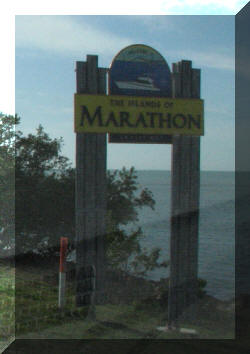 We
arrived in The Islands of Marathon where our motel was located late in the
afternoon.
We
arrived in The Islands of Marathon where our motel was located late in the
afternoon.
Our motel was north of the business district.
Our room looked like it began its life as a garage. It was the size of a two car garage. We read a mix of reviews for inexpensive (relatively) rooms on-line . . . this had to be the room in the 'poor' review for our motel. We had no real quality comparison with other motels in the same price range. To us, it was a lot of money - however, many rooms at other motels were two or three times what we paid. Yes, we understand . . . you get what you pay for.
We dropped our luggage in the room. (Now that sounds funny . . . we NEVER travel with luggage.) But, we dropped our luggage in the room, made a couple photographs of our view and headed for the Marathon business district. After our tour of Marathon and dinner we returned to the motel and made additional photographs of our motel experience prior to sitting on pillows in the plastic chairs to watch some television.
Entertainment center . . .
Kitchenette . . .
Dining room and closet . . .
(Yes, the rack over the table was
the only place to hang clothes.)
Air conditioning . . .
King size bed . . .
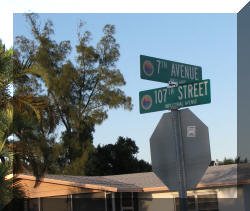 The
streets in Marathon were 'named' with numbers. Streets went one direction. Avenues
went the other direction. Many had a canal behind the houses.
The
streets in Marathon were 'named' with numbers. Streets went one direction. Avenues
went the other direction. Many had a canal behind the houses.
While some of the houses were built more recently, some were older mobile homes that had been added to over the years. They were probably grandfathered from recent building codes.
A 'for sale' 1976 Dodge Ram crew cab reminded us of the one we used to carry our truck camper.
When
we drove by the Turtle Hospital the next night, the Turtle Hospital Ambulance
was parked in front of the building. It would have made a good photograph.
We didn't take a tour of the hospital, because we were not near the hospital during their tour hours.
We had dinner at the restaurant suggest by the motel manager. We could have
done better - it was a food preparation thing.
"Home' again.
Tuesday morning we had breakfast at McDonalds then drove toward Key West. The Keys are full of RV and mobile home parks.

Seven Mile Bridge is the longest bridge on the highway. It connects the town of Marathon in the Middle Keys with Little Duck Key in the Lower Keys. The piling-supported concrete bridge is 35,862 feet or 6.79 miles long.
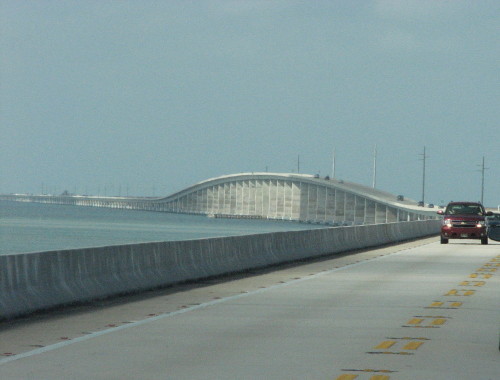
The Seven Mile Bridge bypasses a small island that housed workers building the Overseas Railway in the 1900's. A 2.2 Mile section of the old bridge was the access to the island, but was closed March 4, 2008 because it was considered unsafe. The island, now a museum, is reached by foot or ferry service.

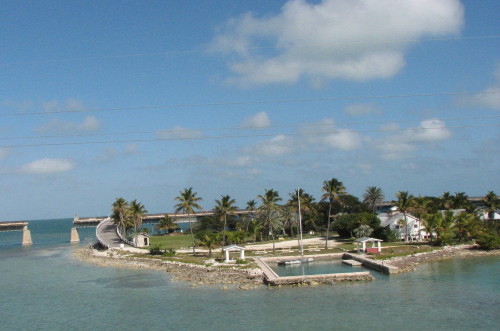
The Pigeon Key Visitor Center and Gift Shop is located on Knight's Key, mile marker 47. Admission to the island cost $11 per adult and $8.50 for students 14 and under (children 4 and under are free). Proceeds benefit the Pigeon Key Foundation and its preservation and restoration efforts.
The old
railroad/automobile bridge was relatively level.
The new bridge was elevated in several places to permit boat traffic.
Some cut-aways were used to block access to various sections of the old bridge. Some were design as passage ways across from the elevated sections of the newer bridge.
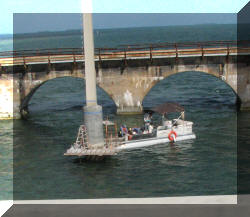 Like
anything else pole maintenance is required.
Like
anything else pole maintenance is required.
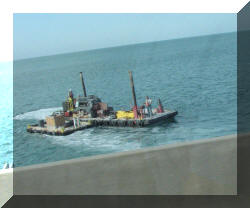 To
maintain the proper depth of water for boats to move between the Gulf of Mexico and the
Atlantic Ocean, dredging is necessary.
To
maintain the proper depth of water for boats to move between the Gulf of Mexico and the
Atlantic Ocean, dredging is necessary.
The entire length of all bridges were not maintained.
 Some
parts are deteriorating badly.
Some
parts are deteriorating badly.
 A lot of the sections of the old bridges that are isolated from
pedestrian traffic are occupied by our feathered friends.
A lot of the sections of the old bridges that are isolated from
pedestrian traffic are occupied by our feathered friends.
Thatch roofed picnic table areas were available in many rest areas.
The views from the rest areas on the Keys were spectacular.
We enjoyed watching these birds fish.
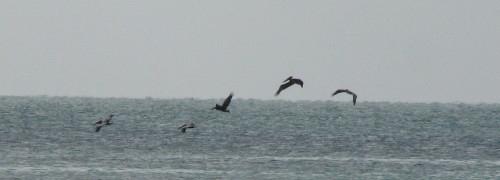
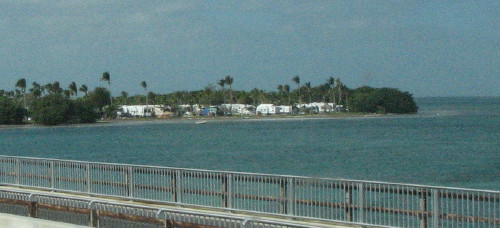 Just to obtain information as a comparison to campground fees in central and
south Florida, we stopped at this campground to collect fee information. What
did we learn . . . it is VERY expensive to camp in a campground on the Keys. We
were not surprised.
Just to obtain information as a comparison to campground fees in central and
south Florida, we stopped at this campground to collect fee information. What
did we learn . . . it is VERY expensive to camp in a campground on the Keys. We
were not surprised.
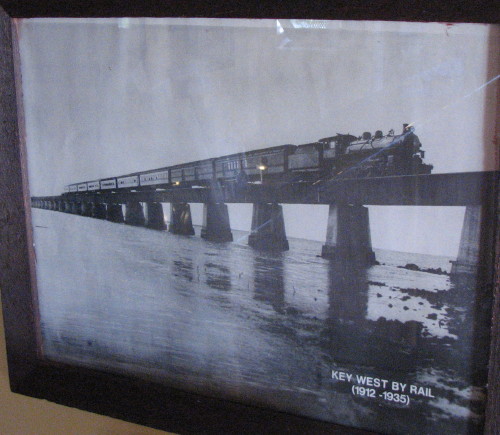 A
photograph of Henry Flagler's Overseas Railway (1912-1935) was hanging in the campground office.
A
photograph of Henry Flagler's Overseas Railway (1912-1935) was hanging in the campground office.
Ah, a side trip during our side trip. And, we were lucky enough to see a deer.
All in all, it was a beautiful ride.
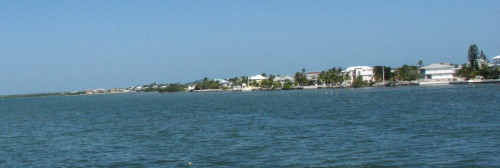
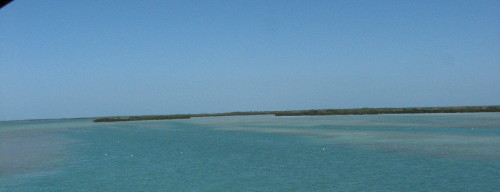
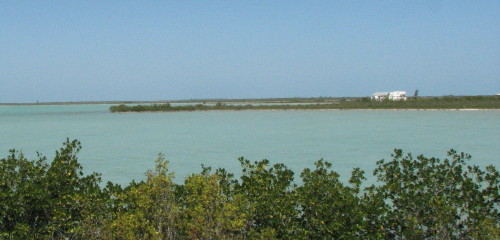 A
little isolated ???
A
little isolated ???
Key West . . . finally.
We stopped by the visitor's center to find it not very helpful. The fellow at the desk was not interested in providing information if it did not result in the sale of tickets. It was a big office space with one counter where he sat and restrooms off an adjacent room. He advised us there was no 'free' parking in Key West but pointed to a location of a $10 all day parking lot.
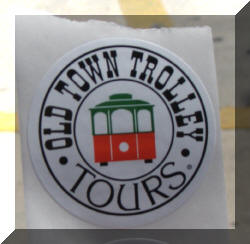
The
$10 parking lot was near Old Town Trolley Stop #3. You could get on and off the
trolley all day.
Cost was $26 each for seniors.
 There
were two other tour vehicles available.
There
were two other tour vehicles available.
<< Another trolley type vehicle . . .
The marina on the Gulf side was packed with boats of all shapes and sizes (mostly BIG),
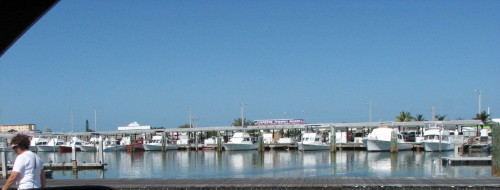
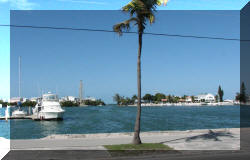 Opening
into Gulf of Mexico . . .
Opening
into Gulf of Mexico . . .
While the trolley stops were mostly at commercial (tourist) locations, we rode by many residential homes and churches.
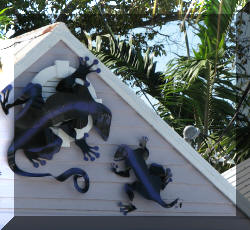 Lunch
at The Six Toed Cat Cafe . . . a great Ruben sandwich.
Lunch
at The Six Toed Cat Cafe . . . a great Ruben sandwich.
The pink house across the street was decorated with purple iguanas.
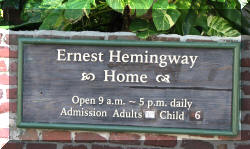 Down
the street a short distance we toured the Ernest Hemingway Home - from the
outside. We decided not to spend the time nor the $12 (each) to tour the inside.
Down
the street a short distance we toured the Ernest Hemingway Home - from the
outside. We decided not to spend the time nor the $12 (each) to tour the inside.
The story is that Hemingway used this lighthouse across the street from his home to find his way home after nights of drinking at Sloppy Joe's bar.
In addition to the 'mass transportation' trolleys and train, many other modes of transportation could be hired or rented.
Businesses that rent bicycles and motor scooters were scattered all over town.
Oh yes, many people used foot power. But, to really 'see' Key West, some form of transportation was required.
While colorful houses were very popular, white houses and white picket fences were as popular.
This house was just a little wider than the car parked in front of it - proof that land is at a premium in Key West.
Some homes were well landscaped.
A classic Denny's . . .
The Conch Republic flag was proudly displayed at many locations.
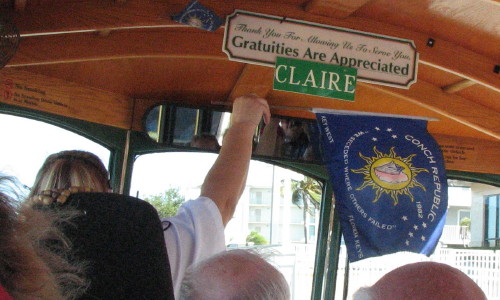 In 1982, the
United States Border Patrol established a road block and inspection points on US
Highway 1 stopping all northbound traffic to search for illegal drugs and
illegal immigrants. The Key West City Council repeatedly complained that
this major inconvenience to people traveling from Key West was hurting their tourist
industry. After attempts to get a legal injunction against the blockade
failed, city officials declared the independence of the city of Key West, calling
it the Conch Republic. After one minute of secession, the mayor surrendered to
an officer of the Key West Naval Air Station and requested one billion dollars
in "foreign aid". The stunt succeeded in generating publicity for the Keys'
plight, and the roadblock was removed.
In 1982, the
United States Border Patrol established a road block and inspection points on US
Highway 1 stopping all northbound traffic to search for illegal drugs and
illegal immigrants. The Key West City Council repeatedly complained that
this major inconvenience to people traveling from Key West was hurting their tourist
industry. After attempts to get a legal injunction against the blockade
failed, city officials declared the independence of the city of Key West, calling
it the Conch Republic. After one minute of secession, the mayor surrendered to
an officer of the Key West Naval Air Station and requested one billion dollars
in "foreign aid". The stunt succeeded in generating publicity for the Keys'
plight, and the roadblock was removed.
Key West doesn't have any natural sand beaches but there are several manmade beaches.

We had been looking for a Home Depot . . . found one in Key West.
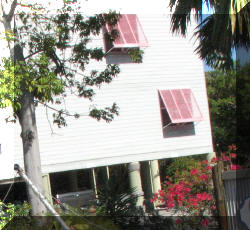 Many of the residents living on Key West are seasonal. When they leave,
they close their shutters to protect their home from storm damage. They are also
used by full-time residents when a storm approaches. Several different styles of
shutters are available.
Many of the residents living on Key West are seasonal. When they leave,
they close their shutters to protect their home from storm damage. They are also
used by full-time residents when a storm approaches. Several different styles of
shutters are available.
A cruise ship can be seen in the distance arriving at Key West.
The public beach was a busier place on weekends.
 A popular tourist attraction is the Southernmost Point of the Continental U.
S. A. - a stop for all the trolleys.
A popular tourist attraction is the Southernmost Point of the Continental U.
S. A. - a stop for all the trolleys.
Everyone wanted their photograph made at the marker.
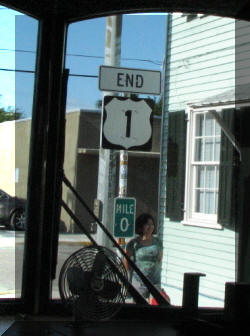 The
trolley driver pointed out the "Mile 0" sign for the end of U.S. 1. He mentioned
that it is the most frequently stolen sign in Key West.
The
trolley driver pointed out the "Mile 0" sign for the end of U.S. 1. He mentioned
that it is the most frequently stolen sign in Key West.
A short time later, Fred noticed a "Mile 0" sign on a porch and was able to make a photograph as the trolley was moving.
Marilyn
Monroe was standing outside a historic movie theatre.
This is a banyon tree - another 'drive-by' on the trolley tours.
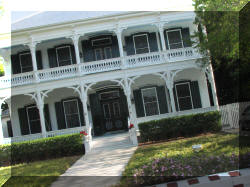 While
most buildings are in very good condition . . .
While
most buildings are in very good condition . . .
. . . a couple buildings were in disrepair. One was on the market at a high price.
This small bakery provided all the key lime pies served in Key West.
The
'Spongeman' almost grabbed Mary Lou.
Sponges . . . Faces carved in coconuts . . .
Roosters freely roamed in Mallory Square Dock and around town in people's
yards.
Sunset Celebration is a nightly art festival at Mallory Square Dock. Participants include arts & crafts exhibitors, street performers, food carts, and psychics. Each night around two hours before sunset locals and tourists alike, come to the water's edge to experience a multicultural happening and to watch the sun sink into the Gulf of Mexico.
The Cypress House is a historic bed and breakfast.
From our trolley, we saw a lot of homes, businesses and other historic
structures. The driver's narration continued but the trolley didn't stop. We don't remember the stories about them - but we have the
photographs.
Many of the old Victorian houses have been or are being renovated.
It was a nice day - mid 70s. While Fred waited on a bench in his shirt sleeves, people were walking by in jackets and parkas. They must live in the south. The temperature was great for us northerners.
We parked in an interesting group of buildings. We could not figure out what it was. When we returned to get the truck, we asked the parking attendant. She told us it was an old lumber yard.
These sharp electric cars were located close to our parking lot.
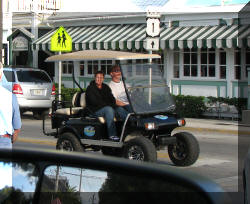 This
appeared to be a privately owned 'street legal' golf cart.
This
appeared to be a privately owned 'street legal' golf cart.
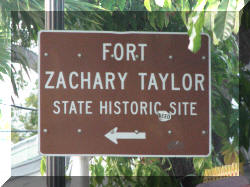 We
drove by the fort but there were no indication that it was open to tourists.
We
drove by the fort but there were no indication that it was open to tourists.
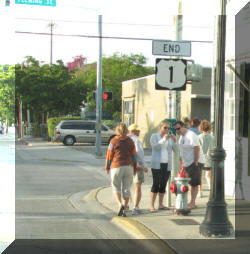 After we retrieved the truck, we drove by the "Mile 0" sign to try to make a
better photograph. No luck! Traffic was heavy and there were so many people
around the sign, we could not even see it. When we processed the photographs, we
saw that our original "Mile 0" photograph was good.
After we retrieved the truck, we drove by the "Mile 0" sign to try to make a
better photograph. No luck! Traffic was heavy and there were so many people
around the sign, we could not even see it. When we processed the photographs, we
saw that our original "Mile 0" photograph was good.
Darkness was setting in as we drove back to the motel.
The next morning we headed north towards Big Cypress.
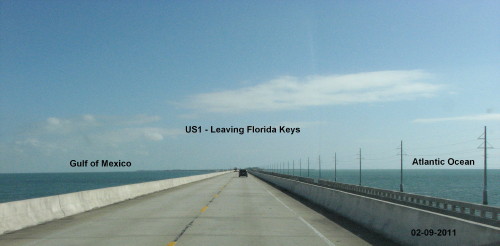
We stopped in at Long Key State Park to see if we would be interested in staying there for two weeks next year. We purchased a 20 minute refundable visitors pass. The pass included a 'gate code' for the lock into the camping area.
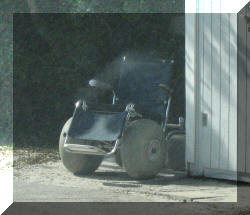 Look
at the tires on this wheelchair . . .
Look
at the tires on this wheelchair . . .
Fred was getting very concerned that the 20 minute pass would expire before Mary Lou opened the gate. Finally, one of the park staff members waiting in the truck behind us offered assistance. He showed her how the numbers on the dials had to be to open. Fortunately, after Mary Lou locked herself outside the gate, she could use the pedestrian path to get back to the truck. (Note from Fred: I'll be surprised if Mary Lou leaves the part in after edit. We had a good laugh about how frustrating it was that the combination lock number alignment had to be exactly positioned to work.)
A bike/walking path weaved its way around and between trees.
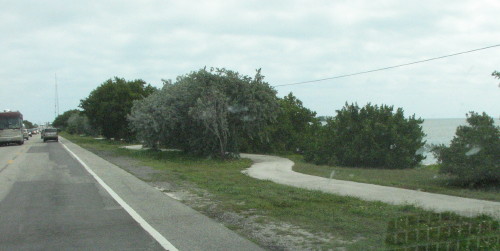
We passed boats were on racks again - in the open and behind screens.
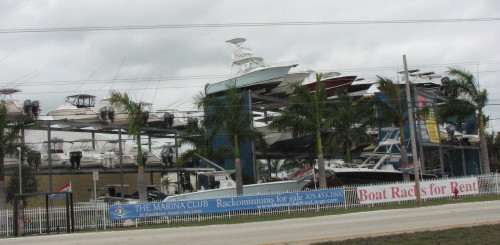

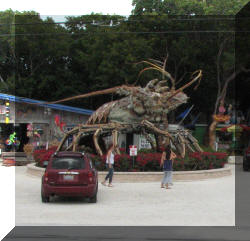 This
lobster could feed a lot of people if it was real.
This
lobster could feed a lot of people if it was real.
 Panther
crossings forced the state to put up a fence along their favorite stretch of the
road. There was a fence in several locations one a couple miles long.
Panther
crossings forced the state to put up a fence along their favorite stretch of the
road. There was a fence in several locations one a couple miles long.
A Dade County Sheriff helicopter landed at this construction site.
The main street into Homestead.
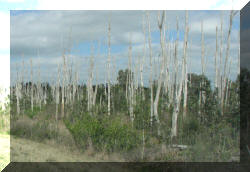 Naked
trees . . . fire or diseased?
Naked
trees . . . fire or diseased?
Migrant workers near Homestead . . .


These field receive their water from the Lake Okeechobee Service Area. Due to the drought conditions in the Everglades, there are specific allocations of water available for each area in south Florida.
Home again to our alligator friends.
We enjoyed our drive on the Florida Keys and our visit to Key West. However, it was a 'been there, done that' trip. We would not feel compelled to revisit Key West. Given our choice, we would select a less populated area.
If you visit Key West, plan on an entire day. Spending the night closer to or in Key West would be a good idea.
MAIN PAGE - Florida Winter Tour - 2011